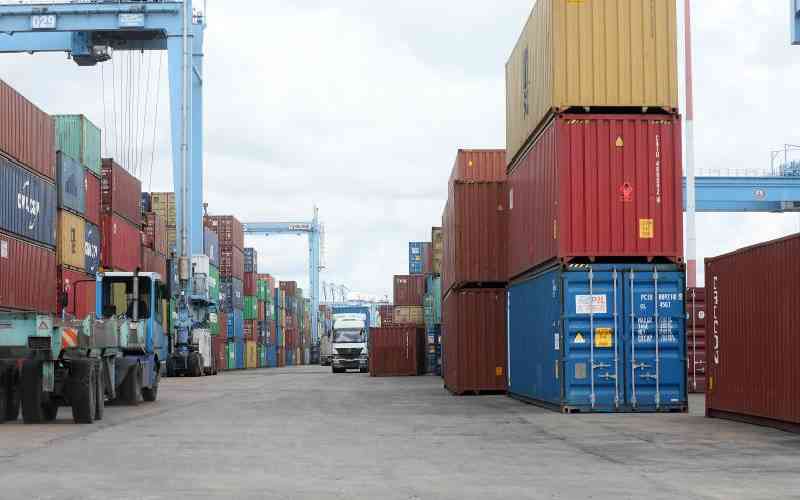What Kenya should do to reap dividends from AfCFTA pact
Opinion
By
Kariuki Ngari
| Dec 28, 2023

As far back as the 8th century, seasonal Monsoon winds facilitated rich economic and cultural exchanges between the Asian, Arabian and East African economies. Merchants relied on the famous Kusi and Kaskazi winds to forge new trading relationships, ultimately determining the development of the East Africa's economy.
Today, as the October-December monsoons trigger the annual short rains season, the region is set to benefit from new 'trade winds' that will define our economic progress for years to come. According to the Future of Trade report recently launched by Standard Chartered, Africa's total trade exports are expected to close at a trillion dollars in value by 2035.
Jumpstarting this shift will be the African Continental Free Trade Area (AfCFTA) that unites 54 markets, and which will contribute 29 per cent of the anticipated growth.
No other region in Africa will benefit more from these new trade winds than East Africa. The Future of Trade report highlights the fact that by 2035, Kenya is expected to grow its annual exports to USD20 billion. In particular, AfCFTA has the potential to further boost exports by an additional 35 per cent.
This is largely because Kenya continues to be East Africa's major economic powerhouse. With a robust private sector and vibrant entrepreneurial culture, Kenya will be able to leverage its unique position as a regional hub to build new trading routes for goods and services.
READ MORE
Gladys Shollei: Why is Kenya approving pesticides banned in Europe and the US?
Tourism industry raises concerns over ETA system delays
Kenya engages US to safeguard exports amid Trump's tariff war
Microsoft turns 50 in the age of AI
Sustainability core to future of Africa insurance industry
COMESA unveils plan to transform Africa's leather industry
How Nairobi-Addis deal is fuelling surge in Kenya's electricity imports
Family Bank profit jumps 38pc to Sh3.4b on higher interest income
Industry leaders, managers urged to support employees' ambitions
To reap the benefits of this trade dividend, Kenya will have to strike a workable balance between its national industrialisation objectives - even as it works to deepen its ability to tap into regional value chains.
This will entail structural improvements in trade facilitation, more investments in cross-border infrastructure systems and the creation of a standardised payments system to benefit from more efficient and cost-effective trade avenues.
At the same time, African governments will also need to get out of their own way. Currently, the existence of several similar but separate trade blocs including the EAC, COMESA, SADC and ECOWAS all pull their member states towards differing priorities.
These overlapping interests often slow down progressive trade and limit the benefits of partnership.
For instance, the cost of participating in overlapping memberships increases the costs of trade governance for regulators and leads to potential confusion for the enforcers, such as border agents.
They also make the products and services we build for Africa less competitive and cost-effective, translating to us losing our competitive edge when it comes to harnessing the winds of intra-Africa trade to deliver efficient regional value chains.
Most importantly, Kenya will need to re-incentivise the private sector. Kenya is currently weathering increasingly complex and challenging economic head winds. Tangible interventions will be required to ensure the country reaps the benefits of the prevailing shifts in global trade winds.
For instance, insufficient trade financing persists as a key barrier to Africa's economic development and export growth. For corporations, the high cost of traditional trade finance mechanisms such as letters of credit prevents firms from effectively leveraging these solutions when required.
SMEs - the backbone of most Africa's economies - are also disproportionately affected by this problem. In Kenya and Tanzania, for instance, one in six SME exporters fails to meet export sales due to a lack of funding, resulting in a USD50,000 loss of trade per SME per year, according to the African Development Bank.
The good news is these commitments already exist.
The Bottom-Up Economic Transformation Agenda (BETA) outlines the Kenyan government's plan to support for implementation bodies and agencies by unlocking challenges and bottlenecks to ensure that the outcomes envisaged in BETA are achieved.
Chief among those challenges is the alignment of government incentives with private sector capacity. This will be critical to ensure efficient and productive industrial and economic outcomes.
In Kenya's case, this will mean heightening its focus on extracting maximal benefits from areas in where the country has a comparative advantage, such as its position as an economic hub, and its growing stature as a start-up haven.
In this regard, we can look to AfCFTA to drive enhanced national and multilateral coordination and policy development that focus on delivering the most efficient economic and industrial settings.
But to truly unlock these opportunities, we will need more cohesive partnerships that transverse the public and private sectors.
A key tool to unlock these challenges and enhance trade will be a technology-first focus.
Opening up digital supply chain solutions can help smaller suppliers access cost-effective working capital financing, boost trade volumes and enable more sustainable and inclusive supply chains.
By 2035, the Future of Trade report highlights that digitising these solutions could boost exports in five key African economies by USD34 billion, 9 per cent over the baseline.
E-commerce is also set to play a more integral role in enabling access to new markets. Seventy-five per cent business leaders polled in the report believe that e-commerce will drive at least 20 per cent of sales in the next two to three years.
While daunting, the challenges facing Africa's trade future are surmountable. Opportunity beckons.

